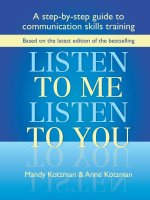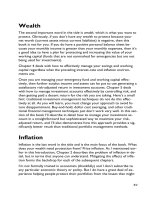ADHD and social skills a step (bookfi org)
Bạn đang xem bản rút gọn của tài liệu. Xem và tải ngay bản đầy đủ của tài liệu tại đây (871.97 KB, 261 trang )
ADHD AND
SOCIAL SKILLS
A STEP-BY-STEP GUIDE FOR
TEACHERS AND PARENTS
Esta M. Rapoport
Rowman & Littlefield Education
Lanham • New York • Toronto • Plymouth, UK
To my parents, Lilyan and Irving Milchman,
and to my brother Hartley
To both my husband Fred, my true love,
and my wonderful children, Mimi, Ian, and Jake,
for all of their everlasting love, encouragement, pride, guidance, and support
without which I could not have written this book
Published in the United States of America
by Rowman & Littlefield Education
A Division of Rowman & Littlefield Publishers, Inc.
A wholly owned subsidiary of The Rowman & Littlefield Publishing Group,
Inc.
4501 Forbes Boulevard, Suite 200, Lanham, Maryland 20706
www.rowmaneducation.com
Estover Road
Plymouth PL6 7PY
United Kingdom
Copyright © 2009 by Rowman & Littlefield Education
All rights reserved. No part of this publication may be reproduced, stored
in a retrieval system, or transmitted in any form or by any means, electronic,
mechanical, photocopying, recording, or otherwise, without the prior
permission of the publisher.
British Library Cataloguing in Publication Information Available
Library of Congress Cataloging-in-Publication Data
Rapoport, Esta M.
ADHD and social skills : a step-by-step guide for teachers and parents /
Esta M. Rapoport.
p. cm.
Includes bibliographical references.
ISBN 978-1-60709-280-3 (cloth : alk. paper) — ISBN 978-1-60709-281-0
(pbk. : alk. paper) — ISBN 978-1-60709-282-7 (electronic)
1. Attention-deficit-disordered children—Education—United States.
2. Attention-deficit-disordered children—United States. 3. Social skills—
Study and teaching—United States. I. Title. II. Title: Attention-deficit
hyperactivity disorder and social skills.
LC4713.4.R37 2009
371.39'6—dc21
2009011661
ϱ ™ The paper used in this publication meets the minimum requirements of
American National Standard for Information Sciences—Permanence of Paper
for Printed Library Materials, ANSI/NISO Z39.48-1992.
Manufactured in the United States of America.
CONTENTS
FOREWO RD , Bruce S. Cooper, Ph.D.
P REFA CE
xiii
ACKN OWL EDGM E NTS
xxiii
IN T RODUCTION
1
ix
1
WHAT I S ATTE NTI ON-DEFI C I T/
HY PE RAC TIV I TY DI SOR D E R,
A NYW AY?
7
Common Misconceptions about Children
with ADHD
Does ADHD Have a History?
11
12
iii
CONTENTS
2
SOC IAL SKILLS DE FIC I TS I N
C HILDRE N W I TH AD H D
Admit It—This Child Is So Annoying!
What Is Causing These Problems?
Why Don’t Children with ADHD Learn
Positive Social Skills?
Some Real-Life Examples of Socially
Inappropriate Behavior
Teachers’ Ratings of Social Skills That Are
Vital for School Success
Real-Life Stories of Children with ADHD
Social Skills Problems
Children’s Awareness of Their Behavior
Responses of Homeschool Parents to Their
Children’s Socially Inappropriate Behavior
Children’s Actual Behavior
Misunderstanding Others’ Social Cues
Children Who Have Been Bullied: True
Stories
3
SOC IAL SKILLS: LIST S A N D
DE SC RI PTI ONS
What Does It Mean for a Child to Have
Good Social Skills versus Poor Social
Skills?
List of Social Skills That Children with
ADHD Need to Learn (and Teachers
Need to Teach)
Social Skills That Teachers Expect Children
with ADHD to Exhibit
A Real-Life Story of a Child with ADHD
Losing Self-Control
Social Skills That Teachers Rated as Vital
for School Success
What Social Skills Do Parents Want Their
Children to Learn?
iv
21
22
24
25
30
34
34
35
36
37
38
40
45
45
46
49
49
50
51
CONTENTS
4
5
6
WHAT C AN TE AC HE R S A N D
PARE NTS DO TO HE LP
CH ILDRE N W I TH ADHD TO
L EARN POSI TI V E SOC I A L
SKILLS?
53
Laying the Foundation
Cooperative Teaching
Strategies for Teachers
Techniques for Parents
53
59
63
66
WHE RE SHOULD I BE GI N ?
69
Get the Child on Board
Methods
71
72
TH E SOC IAL SKILLS AND H O W
TO TE AC H THE M
73
Social Skill 1: Maintaining Eye Contact
Social Skill 2: Greeting Others Nonverbally
Social Skill 3: Greeting Others Verbally
Social Skill 4: Introducing Oneself
Social Skill 5: Initiating Conversations
Social Skill 6: Joining Ongoing Activities
Social Skill 7: Volunteering to Help Peers
Social Skill 8: Inviting Others to Join
Activities
Social Skill 9: Asking an Adult for Help
Social Skill 10: Answering the Telephone
Social Skill 11: Asking Permission to Use
Property
Social Skill 12: Reporting Accidents to
Appropriate Persons
Social Skill 13: Questioning Rules That May
Be Unfair
Social Skill 14: Giving a Compliment
Social Skill 15: Responding to a Compliment
v
73
74
75
76
78
81
84
86
89
91
94
95
96
98
102
CONTENTS
Social Skill 16: Telling an Adult When
Something Is Appreciated
Social Skill 17: Accepting People Who Are
Different
Social Skill 18: Accepting Peer Suggestions
for Activities
Social Skill 19: Cooperating with Peers
Social Skill 20: Compromising by Reaching
Agreement
Social Skill 21: Responding to Teasing
Appropriately
Social Skill 22: Receiving Criticism Well
Social Skill 23: Controlling Temper in
Conflicts with Adults
Social Skill 24: Responding Appropriately
When Pushed or Hit
Social Skill 25: Controlling Temper When in
Conflict with Peers
Social Skill 26: Diffusing Negative Behavior
When Someone Is Annoying
Social Skill 27: Taking Something with
Permission
Social Skill 28: Social Skills Taught through
Curriculum
Social Skill 29: Social Skills Taught through
Conversations with the Child
Social Skill 30: Sitting Quietly When Being
Taught by Teacher or Parent
Social Skill 31: Pulling Hair Back When
Preparing Food
Social Skill 32: Not Touching Your Hair
When Preparing Food
Social Skill 33: Being Polite or Asking
Teacher or Parent Politely to Hand Him
Needed Items
vi
103
105
110
111
116
125
129
132
134
135
136
138
140
142
145
147
147
149
CONTENTS
Social Skill 34: Listening to All Instructions
Given by Teacher or Parent without
Interrupting
Social Skill 35: Not Burping Out Loud
Social Skill 36: Not Exhibiting Distractible
Behaviors
Social Skill 37: Learning Socially
Appropriate Behavior from Others
Social Skill 38: Learning Social Skills
Taught through Interactions with
Siblings
Social Skill 39: Learning Social Skills
Taught through Temper Tantrums
Social Skill 40: Learning Social Skills When
Academically Frustrated
Social Skill 41: Staying on Task and Not
Leaving Room When Academically
Frustrated
Social Skill 42: Learning Social Skills
Taught through Modeling Teacher’s or
Parents’ Behavior
Social Skill 43: Conversing with Children
or Adults
Social Skill 44: Respecting Elders
Social Skill 45: Following Instruction Given
by Teachers and Parents
Social Skill 46: Having Good Manners
Social Skill 47: Being Responsible
Social Skill 48: Interacting through Teacher
or Parental Coaching
Social Skill 49: Keeping Promises
Social Skill 50: Learning Social Skills Taught
Every Day
Social Skill 51: Having Good Character
Social Skill 52: Behaving Properly in Public
vii
151
154
156
156
167
169
173
176
179
181
184
187
189
191
194
198
202
203
206
CONTENTS
7
8
SUPPOR TI NG SKILL
DE V E LOPM E NT
209
What Is Positive Behavior Support?
Functional Behavior Assessment
Gathering the Information
The Observation
How Long Is the Observation?
Developing Hypotheses about the Child’s
Socially Inappropriate Behavior
Questions the Team Can Ask Themselves
Changing the Child’s Environment
209
211
212
213
214
C ONC LU SI ON
219
215
215
216
N OT ES
223
BIBLIO GRAPHY AND SUGGE S TE D
RESO URC E S FOR TE AC HE RS A N D
PARENTS
225
A BOUT THE AU THOR
235
viii
FOREWORD
A
ttention-deficit/hyperactivity disorder, or ADHD, is as
confusing a term as it is a condition affecting our children.
Kids who suffer with this disorder appear confused, distracted,
angry, and disrespectful, talking endlessly with high energy,
which is not an easy condition for them, their families, or their
schools to deal with. But we are coming to understand this
disorder and how to cope with it, thanks to this book by Esta
Rapoport, which is aimed at managing the ADHD in schools
and, by implication, at home.
The insights and methods presented in the book are primarily meant for the adults who interact with these children and
can then be applied to the children themselves. Living with
and teaching children/students with this disorder can bring out
the worst in teachers and parents, making the adults angry and
prompting them, as Dr. Rapoport explains, to scream “Sit down
ix
FOREWORD
and shut up!” and, often out of frustration, to leave the child to
his/her own devices. In contrast, reaching out to these children,
reinforcing their better behavior, and changing their negative
actions can have amazing effects, as Rapoport shows and explains so clearly and elegantly in this much-needed book.
If children with ADHD aren’t taught how to manage themselves and their behavior, they may spend the rest of their lives
alone, isolated, unmarried, unemployed, and unemployable.
So the stakes are high and lessons to be learned are critical.
How can I teach you, live with you, help you if you don’t sit
still, listen, respond, be quiet, and grasp what I’m saying and
be responsive? Uniquely, too, Dr. Rapoport is not afraid to put
herself personally into the picture, telling stories about how
she worked with these children (Timmy being a good example), meeting with the children’s school principal and teachers,
and involving herself with the children’s reactions to schools.
She gives examples from her research about students with the
disorder, such as, they are “running around in circles,” “talking
was also nonstop,” “avoiding eye contact, and being uncontrollable.” We can feel these conditions and come to understand
better the children and what can and should be done to help
them in practical terms.
Each chapter in the book treats a set of particular Social
Skills, numbered from one through fifty-two, giving examples
of the following: (1) how these conditions manifest themselves
in daily life (at home and at school); (2) methods for grappling
with the problem; and (3) strategies for coping. Nicely, this
book has managed to organize the skills, from the first one,
that is closest and most subtle: Social Skill 1, Maintaining Eye
Contact, to a more behavioral one, say, Social Skill 15, Responding to a Compliment, to the most public and general in the set,
Social Skill 52, Behaving Properly in Public.
For example, take Social Skill 22, Receiving Criticism Well:
children with ADHD find it difficult to hear negative assessments of their behavior because these kids are yelled at, criticized, and belittled dozens of times per day: “Be quiet,” “Stop
x
FOREWORD
hitting,” “No biting is allowed,” “I told you three times to clean
up your room.”
The book then gives adults a series of “methods” for dealing
with this problem, using stories, CDs, listening to the child, and
helping the child to build confidence so he or she can learn to
listen, respond, and “take criticism.” And, as the child behaves
better, she or he will receive less criticism and take advice
more easily (Social Skill 22). Like most of the methods and
strategies in this book, one technique leads to improvement in
another, which leads to more acceptable situations in the next
situation. So the child learns to cope, and the adult becomes
more patient, more skillful, and better at managing the conditions of this disorder.
In chapter after chapter, the book provides clear, direct,
and realistic advice to teachers and parents: Be aware of the
signs, the changes in behavior; know the child and be aware of
changes in “typical behavior” and then act quickly and directly;
speak with the child, quietly and privately. You can give the
child a book about students who are being bullied and can
share it with the family and the child. Be engaged, aware, and
follow up, and get the child to report when he or she is being
bothered and bullied, and steps should be taken to stop other
children from picking on the child with ADHD.
Most important, everyone should realize that these kids with
ADHD don’t want or like being that way—but that they cannot
help themselves. Starting there, adults should help children
control their emotions and behaviors, urging them to make
and keep friends. Thus, this book allows us to understand the
nature of these students, the reactions they can create from
teachers (parents) and other students, and gives us fifty-two
different social skills in a kind of hierarchy to teach children
with ADHD to deal with their conditions. Thus, it breaks the
key skills for the kids down and provides useful advice to the
adults about being positive, working together, being observant,
making and testing hypotheses, and helping the adults through
the home and school to change the child’s environment.
xi
FOREWORD
What could be more useful? This book is clearly written,
uses real examples and methods, case by case, and can assist
real children with ADHD by helping those in the child’s environment: home, school, and elsewhere. And I would say, too,
that these ADHD techniques and skills can be used in dealing
with all children as they grow up, helping them learn to be responsible social creatures, and to learn to live at home, school,
work, and in the community. The process is lifelong, and the
advice and methods in this book are applicable throughout the
child’s world. The kids with ADHD often force us to work more
carefully and thoroughly since their conditions are more exaggerated and severe. All children need understanding adults,
can use “structure,” “consistency,” and “people to listen and
help them”—it’s just more critical for the student with ADHD,
as this book so well explains and illustrates.
Bruce S. Cooper, Ph.D.
Fordham University Graduate School of Education
xii
PREFACE
I
walked into the school where I would be working for the next
year and was stunned to see Timmy, an eight-year-old, curly
haired, mop-topped imp sitting right outside of the principal’s
office. He had his head down and was not talking to anyone. I
sat down next to him and after just a few minutes, tears began
to flow gently down his cheek. He told me that he was trying
to make himself invisible so that no one could see him as they
walked by, because unlike him, they were going to gym class.
Why was he not going to gym class like everyone else?
His teacher told me that he was not yet ready to go to gym,
art, music, or recess with the other children because he talked
incessantly; he did not pay attention to instructions; he interrupted whomever was speaking; and he continuously touched
others. How obstructive could a little boy’s behavior be that
would prevent him from attending classes and activities that
would seemingly be fun for him?
xiii
PREFACE
In a way, one could not blame his teacher. Apparently the last
time he entered the gym, he immediately darted to the closet
where all of the equipment was stored and one by one, threw
each and every piece of equipment out onto the gym floor. In
fact, he threw some of the balls at the other children.
His behavior was certainly obstructive. However, was there
not one teacher who could try to teach him how to behave
appropriately? Timmy’s teacher quickly told me the answer to
that question. She said that “He just wouldn’t listen.” She also
told me that she “just didn’t have the time to work with one
child.” Timmy was one student in an eight-student class. Was
she kidding? Her response gave me a clear picture of how she
felt about Timmy and his behavior.
I know that you are asking yourself, why did Timmy exhibit
these socially inappropriate behaviors? Why did he exhibit
poor social skills? Timmy had a diagnosis of attention-deficit/
hyperactive disorder (ADHD) as well as a diagnosis of giftedness. The symptoms that he exhibited are typical for children
with the diagnosis of ADHD as listed in the Diagnostic and
Statistical Manual of Mental Disorders (DSM-IV-TR). Certainly,
Timmy exhibited the following from the DSM-IV-TR:
(b) often has difficulty sustaining attention in tasks or play
activities
(c) often does not seem to listen when spoken to directly
(h) is often easily distracted by extraneous stimuli
(e) is often “on the go” or often acts as if “driven by a motor”
(f) often talks excessively (APA 2000, p. 66).
In fact, if children with ADHD do not learn how to diminish or
self-regulate these symptoms, they may arguably spend their
entire adult lives feeling friendless, devoid of spouses, and having difficulty obtaining and keeping a job.
As hard as it is for me to admit it, you can see how a child
like Timmy could be annoying for other children to have
around. It was just about impossible for Timmy to get children
xiv
PREFACE
to like him, let alone to make friends. Each time I entered the
classroom, Timmy appeared to be happy.
However, within a few moments, his face showed more and
more sadness and hurt. Whenever he tried to talk to his classmates, they would ignore him or make insulting comments to
him. His behavior would then suddenly become inappropriate.
This was the cycle of Timmy’s behavior: he would talk to his
classmates; they would ignore him or make hurtful comments
to him; and then he would exhibit socially inappropriate behavior that would irritate them. This cycle was prevalent during all of his classes as well as throughout lunch.
When I came to school to work with Timmy, no one wanted
to sit next to him at lunch. Let us look at what typically happened. As Timmy ate his lunch, if the other children did not
get up from their chairs immediately upon seeing him walking
toward them and sit somewhere else, he would speak to them.
They would say insulting comments to him, such as, “Oh no,
here he is again, the talking monster,” or “The jumping jack in
a boy’s body is sitting here, yuck.” He would then exhibit inappropriate behavior, such as purposely chewing his food with
his mouth open.
The other children would then say to me that “He grosses us
out.” Since Timmy clearly did not understand how his behavior was causing his peers to respond to him in a negative way,
he did not do anything to change his behavior. I tried to talk to
Timmy to help him to understand exactly why his peers were
rejecting him, but he just did not understand. He would speak
to me about feeling rejected and unwanted but just did not understand the origin of his own socially inappropriate behavior.
So I tried a different approach.
I asked for and received permission from his parents, the
other children’s parents, and the school to videotape him during class, in lunch, in recess, and in gym class. I included the
stipulation that the videotape was for my use only. The other
children thought that I was videotaping them as well, so they
xv
PREFACE
did not complain. I only had to show Timmy a few minutes of
the videotape before he got the idea of the annoying nature of
his behavior. That tape was a great teaching tool for me over
the year that I worked with him, but I will not get into those
details here.
After working with Timmy during that year, I knew that
I had to find a way to help teachers and parents teach social
skills to children with ADHD, so that these children’s socially
inappropriate behavior would not result in their becoming isolated, bullied, and rejected. I knew that I had to do something
to try to prevent other children with ADHD from experiencing
their childhood years in a sad and lonely place like the world
in which Timmy lived. If children with ADHD learn positive
social skills, they will naturally feel better about themselves. If
they succeed in learning these socially appropriate skills, they
will be less likely to form negative opinions about themselves,
as Timmy had already done at eight years old.
Every author has a motivating force behind their writing.
Timmy was my motivating force. I wrote this book to help
those individuals who work with children such as Timmy to
understand this conundrum called ADHD. I also wrote this
book to help the individuals who work with these children to
teach them how to self-regulate their socially inappropriate
behavior, so it will be easier for them to have positive social
interactions. Even though the audience for this book is actually teachers, as one of my students reminded me, “Parents
are children’s first teachers” (personal communication, Terri
Graunitz, November 2008). Therefore, I will say here that
I wrote this book to help teachers and parents learn how to
teach social skills to children with ADHD.
Teachers in our schools as well as parents at home need
to learn how to teach children with ADHD appropriate social
skills so these children can avoid being mistreated like Timmy
and so many other children in our country who have a diagnosis of ADHD. Children such as Timmy are rebuffed and bullied
by their peers every day in classrooms across the United States.
xvi
PREFACE
Their self-esteem and self-confidence are being negatively affected because of the reactions of others toward their behavior.
Later in this book you will hear about children from my field
research who experienced being bullied because they behaved,
like Timmy, in different ways from other children, often appearing vulnerable. What do people see first when they encounter children with ADHD? Trust me that it is not their good
heart; it is their socially inappropriate behavior.
One of my mentors asked me, “Who should care about the
social skills problems of children with ADHD?” Everyone must
care. Why do I say that? Most educators agree that there are
at least 3,290,000 children with ADHD in our schools today.1
I would say that that is a good enough reason to care about
children with ADHD. It was certainly a good enough reason for
me to write this book.
These children could be your children.
These children could be your sister’s or your brother’s children.
These children could be your friend’s children.
If you are a teacher, an administrator, a parent, a psychologist, a psychiatrist, a pediatrician, a pediatric neurologist or a
social worker, or in fact, anyone who comes in contact with
children with ADHD frequently, you cannot ignore the plight
of children who behave in a socially inappropriate way. The
manner in which these children behave is not of their own free
will but is due to this enigma called ADHD. These children
behave in ways that are socially inappropriate because they
have social skills difficulties. In other words, they have not yet
developed the social skills that are necessary to interact either
with other children or adults.
Back to Timmy. Do you remember that I discussed how
Timmy’s teacher felt about him? Let me mention some of the
reactions of the other children in the classroom, among others.
Every day that I entered the classroom, another child would
come running up to tell me what a horrible thing Timmy had
done to them. Then, they asked me, “Could you please keep
Timmy away from us?”
xvii
PREFACE
I told these children that those kinds of comments were
unacceptable and hurtful. However, even though I told them
to stop saying those negative things about Timmy, they did
not do so. Timmy heard every one of these hurtful comments,
which made him tear up right in front of me. He quickly became angry at the child who said it, which caused him to strike
out against that child, as well as all of the children in his class,
even more.
In an attempt to find out more about Timmy, I spoke to his
mom. According to her, children have been saying negative
comments to Timmy ever since he was in preschool. She also
told me that Timmy was always so hyperactive, that it seemed
as if he was perpetually in motion. As I observed him in class,
he would talk in an obsessive way about anything and everything. For instance, he would ask why the teacher was wearing
her hair in a ponytail, perhaps thirty times.
Additionally, his comments were almost never on the topic
being discussed. In addition, when he realized that no one was
listening to him, he began to move closer to the child or adult
to whom he was speaking. He would also try to touch that child
or adult. If you are familiar with the “Close Talker” in the Seinfeld episodes, that was the style of Timmy’s interactions. The
more the child became annoyed, the more annoying Timmy
became. Consequently, none of the children wanted to sit next
to him or be anywhere near him. Imagine how an eight-yearold boy would feel when no one, not his peers or his teachers,
wanted to be around him. This sweet and discerning child was
rejected by everyone. He was such a bright little boy. Why
couldn’t he add his insightful comments to the conversations
in class or at recess?
Sadly, he never was given the chance to enter into those
conversations, either during gym, art, or recess, because as I
have said before, he was not permitted to attend any activity
where the teacher thought that he might be disruptive. His
teacher felt that he was misunderstanding much of the instructions that she gave the class, in terms of how to go about doing
xviii
PREFACE
activities as well as instructions concerning how to do his class
work. However, in the year that I worked with Timmy, his
teacher never attempted to clarify those instructions for him.
In fact, it appeared that even though he was so many steps
ahead of everyone intellectually (he had a diagnosis of giftedness), he could not attend to either his teachers or his peers
for an extended period of time without “bouncing all over the
room,” as his teacher told me. Because of Timmy’s socially
inappropriate behavior, his teachers responded unkindly to
him, while his peers verbally abused and rejected him. Timmy
certainly needed to learn how to behave in a more socially appropriate way, and apparently, I was the one who was going to
teach him.
I was hired to be what was called an itinerant teacher in the
New York City public schools. My job description stated that I
was to supervise eight-year-old Timmy in his classroom for six
hours a day for four days a week for a period of one year.
I believe the actual reason that I was hired was that they
wanted me to isolate Timmy from the other children as well as
from the teacher. The principal thought that if I was in charge
of Timmy, Timmy’s behavior, which was the only perception
they had of Timmy, would not annoy anyone.
Over that year, I got to know Timmy well. He told me how
terrible he felt when other children rejected him, and that he
so desperately wanted to have a friend. Without going into
exactly what interventions I used to remediate his inappropriate behavior, I can tell you that from that first day forward, I
observed the other children rejecting Timmy and saw how it
affected his self-esteem. Little by little, this cute little boy became very insecure and felt very unwanted.
He would walk with his head down so no one could say
anything negative to his face. How do I know that? He told me
so. Additionally, I observed him exhibiting that type of body
language, which certainly validated what he had told me. More
often than not, I would see tears streaming down his little face
when I tried to get him to maintain eye contact. I needed to
xix
PREFACE
have him maintain eye contact, of course, so that I could be
sure that he was paying attention when I was teaching him
social skills.
There is hope for children like Timmy in terms of learning
social skills. Even though it took a year for me to help Timmy
learn how to self-regulate his behavior, by the end of the year
he was attending gym class, with me in tow. It was a good
thing since my rusty skills as a soccer coach came in handy
that year!
The other children were learning how to play soccer, so
I taught Timmy to play as well. I ran right next to him and
helped to model soccer skills for him. On the last day of school,
Timmy’s class was playing soccer. I convinced the gym teacher
to permit him to play on one of the teams. The score was tied
at 2-2. I signaled to one of the other boys to pass the ball to
Timmy, who was waiting right in front of the goal.
The other little boy dribbled the ball to Timmy. Timmy
dribbled the ball a few more feet, and with a good “foot” kicked
the ball into the goal for the point to win the game. I still become emotional upon thinking about the end of this rather
tumultuous story. After Timmy kicked the ball into the goal,
his “team” jumped on top of him, chanting his name: “Timmy,
Timmy, Timmy!” As I watched each and every one of those
children slap Timmy a high-five, I was just stunned to see how
far Timmy had come.
I saw that Timmy felt so proud of himself. I could also see
that all of the hard work that we had done together over that
past year was worth it. I am not telling you that that was the
end of Timmy’s socially inappropriate behavior. I will tell you,
though, that from that point onward Timmy knew that he was
capable of self-regulating his socially inappropriate behavior.
He began to have some ownership over his socially appropriate
behavior as well.
Now that I have given you a real-life example of how poor
social skills can affect a child with ADHD and the people
xx
PREFACE
around him, I will take you on a long journey down the road of
teaching social skills to children with ADHD. So let us begin.
NOTE TO THE READER
For clarity purposes, I am referring to a child with ADHD as
“he” instead of “she” in this book, even though clearly there are
many girls who have ADHD as well. Also, the names used are
pseudonyms in order to protect the privacy of all individuals
discussed in this book.
xxi
We don’t accomplish anything in this world alone . . .
and whatever happens is the result of the whole tapestry of one’s life and all the weavings of individual
threads form one to another that creates something.
—Sandra Day O’Connor
ACKNOWLEDGMENTS
T
o my mentor and friend, Bruce S. Cooper, professor of
education leadership and policy at Fordham University,
without whom this journey would never have begun nor would
have come to fruition
To Thomas F. Koerner, vice president and editorial director,
Rowman & Littlefield Education, who always kept me laughing
To the children with ADHD with whom I have known and
worked, who gave me inspiration and taught me patience
To my students from The College of New Rochelle, who listened to my stories and enriched me with their own
To my husband Fred, for his constant inspiration, support,
loving guidance, and pride
To my children Mimi, Ian and Jake and my daughter-in law
Leah for their continuous interest, questions, suggestions, encouragement, support and excitement for my book
xxiii
ACKNOWLEDGEMNTS
To my in-laws, Blanche and Murray Rapoport, for their curiosity and encouragement
To my wonderful friends for their enthusiasm and support,
especially my buddy, Ellen Freiman, who constantly reassured
me that I would finish this book
And finally to Daisy, for making me get up from my computer to take breaks, and to Ruby, for all of those hugs, attention and love late into the night when I was writing
xxiv









